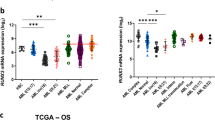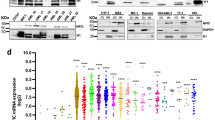Abstract
AML1/RUNX1 is a critical transcription factor in hematopoietic cell differentiation and proliferation. From the AML1 gene, at least three isoforms, AML1a, AML1b and AML1c, are produced through alternative splicing. AML1a interferes with the function of AML1b/1c, which are often called AML1. In this study, we found a higher expression level of AML1a in acute lymphoblastic leukemia and acute myeloid leukemia (AML)-M2 patients in comparison to the controls. Additionally, AML1a represses transcription of promoter of macrophage colony-stimulating factor receptor mediated by AML1b, indicating that AML1a antagonized the effect of AML1b. To investigate the role of AML1a in hematopoiesis and leukemogenesis in vivo, murine bone marrow mononuclear cells were transduced with AML1a and then transplanted into lethally irradiated mice, which developed lymphoblastic leukemia after transplantation. Taken together, these results indicate that overexpression of AML1a may be an important contributing factor to leukemogenesis.
This is a preview of subscription content, access via your institution
Access options
Subscribe to this journal
Receive 12 print issues and online access
$259.00 per year
only $21.58 per issue
Buy this article
- Purchase on Springer Link
- Instant access to full article PDF
Prices may be subject to local taxes which are calculated during checkout





Similar content being viewed by others
References
Miyoshi H, Ohira M, Shimizu K, Mitani K, Hirai H, Imai T et al. Alternative splicing and genomic structure of the AML1 gene involved in acute myeloid leukemia. Nucleic Acids Res 1995; 23: 2762–2769.
Miyoshi H, Shimizu K, Kozu T, Maseki N, Kaneko Y, Ohki M . t(8;21) breakpoints on chromosome 21 in acute myeloid leukemia are clustered within a limited region of a single gene, AMLl. Proc Natl Acad Sci USA 1991; 88: 10431–10434.
Nucifora G, Birn DJ, Espinosa R, Erickson P, LeBeau MM, Roulston D et al. Involvement of the AML1 gene in therapy-related leukemia and in chronic myeloid leukemia in blast crisis. Blood 1993; 81: 2728–2734.
Golub TR, Barker GF, Bohlander SK, Hiebert SW, Ward DC, Bray-Ward P et al. Fusion of the Tel gene on 12p13 to the AML1 on 21q22 in acute lymphoblastic leukemia. Proc Natl Acad Sci USA 1995; 92: 4917–4921.
Meyers S, Lenny N, Hiebert SW . The t (8; 21) fusion protein interferes with AML-1B-dependent transcnptional activation. Mol cell Biol 1995; 15: 1974–1982.
Tanaka T, Tanaka K, Ogawa S, Kurokawa M, Mitani K, Nishida J et al. An acute myeloid leukemia gene, AML1, regulates hemopoietic myeloid cell differentiation and transcriptional activation antagonistically by two alternative spliced forms. EMBO J 1995; 14: 341–350.
Okuda T, van Deursen J, Hiebert SW, Grosveld G, Downing JR . AML1, the target of multiple chromosomal translocations in human leukemia, is essential for normal fetal liver hematopoiesis. Cell 1996; 84: 321–330.
Wang Q, Stacy T, Binder M, Marín-Padilla M, Sharpe AH, Speck NA . Disruption of the Cbfa2 gene causes necrosis and hemorrhaging in the central nervous system and blocks definitive hematopoiesis. Proc Natl Acad Sci USA 1996; 93: 3444–3449.
Ichikawa M, Asai T, Saito T, Seo S, Yamazaki I, Yamagata T et al. AML-1 is required for megakaryocytic maturation and lymphocytic differentiation, but not for maintenance of hematopoietic stem cells in adult hematopoiesis. Nat Med 2004; 10: 299–304.
Kundu M, Compton S, Garrett-Beal L, Stacy T, Starost MF, Eckhaus M et al. Runx1 deficiency predisposes mice to T-lymphoblastic lymphoma. Blood 2005; 106: 3621–3624.
Uchida H, Zhang J, Nimer SD . AML1A and AML1B can transactivate the human IL-3 promoter. J Immunol 1997; 158: 2251–2258.
Britos-Bray M, Friedman AD . Core binding factor cannot synergistically activate the myeloperoxidase proximal enhancer in immature myeloid cells without c-Myb. Mol Cell Biol 1997; 17: 5127–5135.
Nuchprayoon I, Meyers S, Scott LM, Suzow J, Hiebert S, Friedman AD . PEBP2/CBF, the murine homolog of the human myeloid AML1 and PEBP2b/CBFb proto-oncoproteins, regulates the murine myeloperoxidase and neutrophil elastase genes in immature myeloid cells. Mol Cell Biol 1994; 14: 5558–5568.
Cockerill PN, Osborne CS, Bert AG, Grotto RJ . Regulation of GM-CSF gene transcription by core-binding factor. Cell Growth Differ 1996; 7: 917–922.
Rhoades KL, Hetherington CJ, Rowley JD, Hiebert SW, Nucifora G, Tenen DG et al. Synergistic up-regulation of the myeloid-specific promoter for the macrophage colony-stimulating factor receptor by AML1 and the t(8;21) fusion protein may contribute to leukemogenesis. Proc Natl Acad Sci USA 1996; 93: 11895–11900.
Zhang DE, Hetherington CJ, Meyers S, Rhoades KL, Larson CJ, Chen HM et al. CCAAT enhancer-binding protein (C/EBP) and AML1 (CBF alpha2) synergistically activate the macrophage colony-stimulating factor receptor promoter. Mol Cell Biol 1996; 16: 1231–1240.
Fujii M, Hayashi K, Niki M, Chiba N, Meguro K, Endo K et al. Overexpression of AML1 renders a T hybridoma resistant to T cell receptor mediated apoptosis. Oncogene 1998; 17: 1813–1820.
Daga A, Tighe JE, Calabi F . Leukaemia/Drosophila homology. Nature 1992; 356: 484.
Kagoshima H, Shigesada K, Satake M, Ito Y, Miyoshi H, Ohki M et al. The runt domain identifies a new family of heteromeric transcriptional regulators. Trends Genet 1993; 9: 338–341.
Meyers S, Downing JR, Hiebert SW . Identification of AML-1 and the (8;21) translocation protein (AML-1/ETO) as sequence specific DNA binding proteins: the runt homology domain is required for DNA binding and protein–protein interactions. Mol Cell Biol 1993; 13: 6336–6345.
Wang S, Wang Q, Crute BE, Melnikova IN, Keller SR, Speck NA . Cloning and characterization of subunits of the T-cell receptor and murine leukemia virus enhancer core-binding factor. Mol Cell Biol 1993; 13: 3324–3339.
Ogawa E, Inuzuka M, Maruyama M, Satake M, Naito-Fujimoto M, Ito Y et al. Molecular cloning and characterization of PEBP2b, the heterodimeric partner of a novel Drosophila runt-related DNA binding protein PEBP2. Virology 1993; 194: 314–331.
Frank R, Zhang J, Uchida H, Meyers S, Hiebert SW, Nimer SD . The AML1 /ETO fusion protein blocks transactivation of the GM-CSF promoter by AML1B. Oncogene 1995; 11: 2667–2674.
Bennett JM, Catovsky D, Daniel MT, Flandrin G, Galton DA, Gealnick HR et al Proposals for the classification of the acute leukaemias. French-American-British (FAB) co-operative group. Br J Haematol 1976; 33: 451–458.
Lo Coco F, Foa R . Diagnostic and prognostic advances in the immunophenotypic and genetic characterization of acute leukaemia. Eur J Haematol 1995; 55: 1–9.
Zhang X, Diao S, Rao Q, Xing H, Liu H, Liao X et al. Identification of a novel isoform of iASPP and its interaction with p53. J Mol Biol 2007; 368: 1162–1171.
Fenske TS, Pengue G, Mathews V, Hanson PT, Hamm SE, Riaz N et al. Stem cell expression of the AML1/ETO fusion protein induces a myeloproliferative disorder in mice. Proc Natl Acad Sci USA 2004; 101: 15184–15189.
Ogawa E, Maruyama M, Kagoshima H, Inuzuka M, Lu J, Satake M et al. PEBP2/PEA2 represents a family of transcription factors homologous to the products of the Drosophila runt gene and the human AML1 gene. Proc Natl Acad Sci USA 1993; 90: 6859–6863.
Bäsecke J, Feuring-Buske M, Brittinger G, Schaefer UW, Hiddemann W, Griesinger F . Transcription of AML1 in hematopoietic subfractions of normal adults. Ann Hematol 2002; 81: 254–257.
Sato T, Ito R, Nunomura S, Ohno S, Hayashi K, Satake M et al. Requirement of transcription factor AML1 in proliferation of developing thymocytes. Immunol Lett 2003; 89: 39–46.
Tsuzuki S, Hong D, Gupta R, Matsuo K, Seto M, Enver T . Isoform-specific potentiation of stem and progenitor cell engraftment by AML1/RUNX1. PLoS Med 2007; 4: e172.
Acknowledgements
We are grateful to Hongguang Ying (State Key Laboratory of Experimental Hematology, China) for histological analysis. We thank Prof Misao Ohki (Saitama Cancer Center Research Institute, Japan) and Dr Hiebert (St Jude Children's Hospital, USA) for providing pBlue-script II KS (+) plasmid containing AML1a cDNA and pCMV5-AML1b plasmid, respectively. This work was supported by Major State Basic Research Development Program (2006CB910406) and National Natural Science Fund (30871096) of China.
Author information
Authors and Affiliations
Corresponding author
Additional information
Supplementary Information accompanies the paper on the Leukemia website (http://www.nature.com/leu)
Supplementary information
Rights and permissions
About this article
Cite this article
Liu, X., Zhang, Q., Zhang, DE. et al. Overexpression of an isoform of AML1 in acute leukemia and its potential role in leukemogenesis. Leukemia 23, 739–745 (2009). https://doi.org/10.1038/leu.2008.350
Received:
Revised:
Accepted:
Published:
Issue Date:
DOI: https://doi.org/10.1038/leu.2008.350
Keywords
This article is cited by
-
RUN(X) out of blood: emerging RUNX1 functions beyond hematopoiesis and links to Down syndrome
Human Genomics (2023)
-
Myeloid neoplasms and clonal hematopoiesis from the RUNX1 perspective
Leukemia (2022)
-
Truncated RUNX1 protein generated by a novel t(1;21)(p32;q22) chromosomal translocation impairs the proliferation and differentiation of human hematopoietic progenitors
Oncogene (2016)
-
Overexpression of iASPP-SV in glioma is associated with poor prognosis by promoting cell viability and antagonizing apoptosis
Tumor Biology (2016)
-
LincRNA-uc002yug.2 involves in alternative splicing of RUNX1 and serves as a predictor for esophageal cancer and prognosis
Oncogene (2015)



